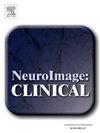Selective association of EEG microstates with clinical symptoms and mutation status in monogenic Alzheimer disease
IF 3.6
2区 医学
Q2 NEUROIMAGING
引用次数: 0
Abstract
EEG microstates are transient and short-lasting periods of stable scalp potential fields that are associated with disturbed temporal dynamics of large-scale brain networks, affected by early synaptic loss in Alzheimer disease (AD). We investigated changes in EEG microstates in presymptomatic (PMC) and symptomatic mutation carriers (SMC) compared to healthy non-carrier (NC) controls in families with autosomal dominant AD (ADAD). A total of 99 EEG recordings from 7 SMC, 17 PMC and 24 NC were selected from a Swedish ADAD cohort. Seven classes (A to G) of microstate topographical maps were fitted to their resting-state EEG. Next, microstate parameters of coverage (fraction of total recording time), duration (average time in milliseconds) and occurrence (frequency per second) of different topographical maps were assessed in repeated-measures analyses to compare differences between NC, PMC and SMC. Selective decreases in coverage of class B (SMC vs NC, p = 0.023) and class C (SMC vs PMC and NC, p = 0.017 and p = 0.004) were observed in symptomatic individuals. In contrast, mutation carriers had a decrease in coverage of class D (SMC and PMC vs NC, p = 0.015 and p = 0.001) and an increase in coverage of class E compared to controls (SMC and PMC vs NC, both p = 0.001). Thus, global brain network dynamics as described by EEG microstate classes were selectively affected in this cohort of monogenic AD, associated with either clinical symptoms (class B and C) or mutation status (class D and E). The latter suggests early mutation-related changes that are detectable already in the presymptomatic stages of disease.

单基因阿尔茨海默病脑电图微状态与临床症状和突变状态的选择性关联
脑电微状态是一种短暂的、持续时间较短的稳定头皮电位场,与阿尔茨海默病(AD)早期突触丧失影响的大尺度脑网络时间动态紊乱有关。我们研究了常染色体显性AD (ADAD)家族中症状前(PMC)和症状突变携带者(SMC)与健康非携带者(NC)对照者脑电图微状态的变化。从瑞典ADAD队列中选择7个SMC, 17个PMC和24个NC共99个EEG记录。静息状态脑电拟合7类(A ~ G)微态地形图。接下来,在重复测量分析中评估不同地形图的覆盖范围(总记录时间的百分比)、持续时间(平均毫秒时间)和出现频率(每秒频率)的微观状态参数,以比较NC、PMC和SMC之间的差异。在有症状的个体中,B类(SMC vs NC, p = 0.023)和C类(SMC vs PMC和NC, p = 0.017和p = 0.004)的覆盖率选择性下降。相比之下,与对照组相比,突变携带者的D类覆盖率下降(SMC和PMC vs NC, p = 0.015和p = 0.001), E类覆盖率增加(SMC和PMC vs NC, p = 0.001)。因此,在这一单基因AD队列中,脑电图微状态类别所描述的全球脑网络动态受到选择性影响,与临床症状(B类和C类)或突变状态(D类和E类)相关。后者表明,在疾病的症状前阶段已经可以检测到的早期突变相关变化。
本文章由计算机程序翻译,如有差异,请以英文原文为准。
求助全文
约1分钟内获得全文
求助全文
来源期刊

Neuroimage-Clinical
NEUROIMAGING-
CiteScore
7.50
自引率
4.80%
发文量
368
审稿时长
52 days
期刊介绍:
NeuroImage: Clinical, a journal of diseases, disorders and syndromes involving the Nervous System, provides a vehicle for communicating important advances in the study of abnormal structure-function relationships of the human nervous system based on imaging.
The focus of NeuroImage: Clinical is on defining changes to the brain associated with primary neurologic and psychiatric diseases and disorders of the nervous system as well as behavioral syndromes and developmental conditions. The main criterion for judging papers is the extent of scientific advancement in the understanding of the pathophysiologic mechanisms of diseases and disorders, in identification of functional models that link clinical signs and symptoms with brain function and in the creation of image based tools applicable to a broad range of clinical needs including diagnosis, monitoring and tracking of illness, predicting therapeutic response and development of new treatments. Papers dealing with structure and function in animal models will also be considered if they reveal mechanisms that can be readily translated to human conditions.
 求助内容:
求助内容: 应助结果提醒方式:
应助结果提醒方式:


